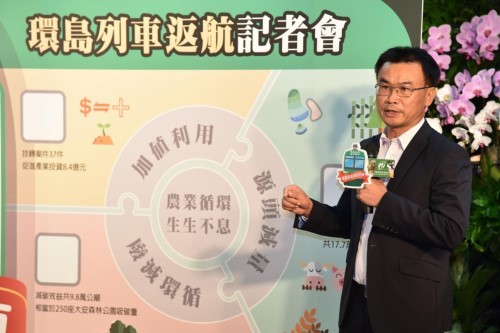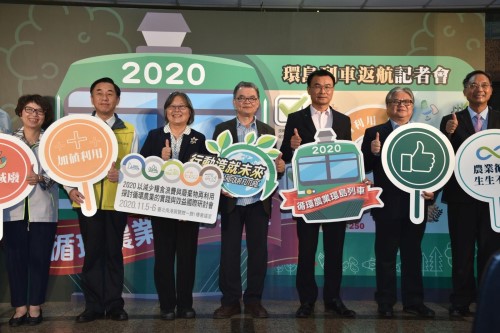News
From Zero to Hero: Turning Waste into Gold – Becoming Asia-Pacific’s Circular Agriculture Bellwether
As the popularity of circular economy rises around the world, Taiwan has achieved quite a remarkable success in circular agriculture. The Council of Agriculture (COA) held a press conference on Nov. 3rd showcasing the achievements of the 2020 CIRCULAR AGRICULTURE TRAIN project so far. Since 2017, the COA has integrated the strength of agricultural, forestry, fisheries, and livestock research institutes, as well as academic and other relevant institutions for the purpose of executing the CIRCULAR AGRICULTURE RESOURCE AND INDUSTRY INNOVATION Program. The re-utilization of resources through circular agriculture in Taiwan amounts to 52,000 mt in 2019, and 125,000 mt in 2020, totaling 177,000 mt so far with an increase rate of more than 200%. In regard to carbon emission reduction, the numbers are 37,000 mt in 2019, and 61,000 mt in 2020, totaling 98,000 mt equivalent to the carbon sequestration capacity of 250 Da-an Parks. Furthermore, the program has attracted NT$840 million worth of investments, and many cases of industry cooperation and technology transfer.

The COA stated that Taiwan’s circular agriculture program has always been actively following the 3 main action plans: 1. Reduce from the origin; 2. Recycle and reduce waste; 3. Value-adding. In recent years, the COA has blended circular agriculture into our daily lives by developing many popular products through creativity and technological innovation of the industry, such as mango seed oil, duck fat, collagen extracted from fish scale and pig lung, among others. These products aim to take up a share in the cosmetic market by turning agricultural waste into gold. It is estimated that the manufacturers of the collagen type 1 supplement drink will process around 120 mt of pig lung annually in the future, generating at least NT$2.86 million of collagen related profit. The Fisheries Research Institute has also developed a set of technology to produce flameless ration heater (FRH) using discarded oyster shells, which will not only solve the problem of processing 169,000 mt discarded oyster shells a year, but also rake in at least NT$10.35 million of revenue for the manufacturers. As for the Forestry Research Institute, it utilizes leftover wood and bamboo materials to produce Taiwania and Maqaw (Litsea cubeba) anti-bacterial paper soap, which consume around 300 mt of surplus forestry related materials a year and generate NT$12 million in production value for the industry.

The COA pointed out that Taiwan produces roughly 4,870,000 mt of agricultural waste annually, which are usually disposed of in landfills or through composting, adding more pressure to the environment. However, the said agricultural waste can be turned into usable raw material through circular re-utilization and technological R&D, therefore creating new value for these “useless” materials. The COA expects to optimize the efficiency of resource allocation and achieve the objective of waste reduction and eventually zero-waste by establishing material source platforms, setting policies and regulations, big data, IoT, AI, core knowledge of agricultural production, among others. On the other hand, in order to promote the achievements of circular agriculture while gathering support and understanding as well as feedback from the general public and industries, the COA launched the so-called 2020 CIRCULAR AGRICULTURE TRAIN event from Oct. 6 to Nov. 3 consisting of 18 promotional presentations all around Taiwan. The attendees showed great interest and expectation towards the core principles of circular agriculture such as centralized processing and treatment, re-utilization equipment and technology, product development, and establishment of circular parks. More than 80% of the participants showed favorable stance towards circular agriculture and are eager to engage in related line of work or support related products. The results reveal that circular agriculture has already gained a firm foothold in Taiwan, where related issues are gradually gaining more approval and attention.
The COA emphasized that Taiwan’s circular agriculture possesses the following advantages which would put Taiwan in the leading role in the Asia-Pacific region for the promotion of circular agriculture: advanced technology, highly supportive general public and industries. In the future, the Council hopes to generate more development and influence by introducing circular agriculture technical modules to other Southeast Asian countries. Taiwan hopes to export rationalized fertilization and precision feeding management technology, along with tillage methods and feed formulation to Southeast Asia where small-scale farming and production is common practice. As for agricultural waste material handling model, it can be brought abroad and set up operations through industrial linkage; therefore drive circular agriculture related industries to flourish in the region, and create broader business opportunities.

In order to continue gathering support and attention for circular agriculture and its development around the world, the COA and the Food and Fertilizer Technology Center for the Asian and Pacific Region (FFTC) co-organized an international symposium on “The Practice and Benefits of Circular Agriculture in Waste Reducing and Recycling”. The 2-day event takes place at the Taipei Nangang Exhibition Center from Nov. 5 to 6. The organizers cordially invite all who support circular agriculture and food-waste reduction to join the symposium online or onsite.
